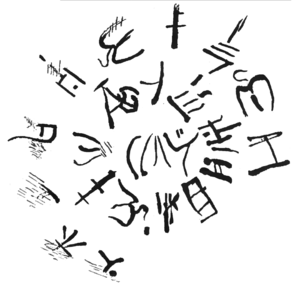Linear A

Linear A is an ancient script used on Crete. No one has been able to translate this script yet. It was one of the writing systems used in Minoan Crete. Another script, about a century older, is called Cretan hieroglyphs. For some time, both methods of writing were used. Probably, each system was used for a special purpose.
Linear A was used from about the 17th century BC until the 15th century BC. Linear B is a script based on Linear A. It has been translated. Archaeologist Arthur Evans found both Linear A and B.
Linear A has about fifty signs that are similar to those in Linear B. About 80% of the signs in Linear A are unique.[1][2] Using the knowledge from Linear B to read Linear A produces text which cannot be read. The language used has been called Eteocretan. It does not seem to be related to any known language. Today, about 70 characters (probably representing syllables) are known. The meaning of about 100 ideographic characters is known. These are combined with the syllables. Also, there are a few numerals whose value is known.
Most texts seem to be lists. A few are probably short dedications, as they are found on libations. So far, no long texts have been found. Straight lines, such as those used for Linear A, are not very practical to use on clay tables. For this reasons, most writing was probably done on other things, such as papyrus or parchment. The problem with these materials is that they do not last as long as clay does. For this reason, most writing on papyrus and parchment has probably been lost.
| Writing system | Geographical area | Time span [3] |
|---|---|---|
| Cretan Hieroglyphic | Crete (eastward from the Knossos-Phaistos axis) | c. 2100–1700 BC.[4][5] |
| Linear A | Crete (except extreme southwest), Aegean islands (Kea, Kythera, Melos, Thera), and Greek mainland (Laconia) | c. 1800–1450 BC[6][7][8][9] |
| Linear B | Crete (Knossos), and mainland (Pylos, Mycenae, Thebes, Tiryns) | c. 1450–1200 BC |
Linear A Media
References
- ↑ Younger, John. "Linear A texts in phonetic transcription". University of Kansas. Retrieved 18 October 2012.
- ↑ Packard, David W. 1974. Minoan Linear A. Berkeley: University of California Press, chapter one: introduction. ISBN 0-520-02580-6
- ↑ Beginning date refers to first attestations, the assumed origins of all scripts lie further back in the past.
- ↑ Rodney Castleden, Minoans. Routledge, 2002 ISBN 1134880642 p.100
- ↑ Andrew Robinson (2009). Writing and script: a very short introduction. OUP Oxford. pp. 55–. ISBN 978-0-19-157916-5.
- ↑ "The Danube script and other ancient writing systems: a typology of distinctive features". Harald Haarmann. 2008. https://www.scribd.com/doc/138393335/The-Danube-script-and-other-ancient-writing-systems-a-typology-of-distinctive-features. Retrieved 2017-10-26.
- ↑ Literacy and history: the Greeks. R.I.C. Publications. 2007. pp. 2–. ISBN 978-1-74126-506-4.
- ↑ Khosrow Jahandarie (1999). Spoken and written discourse: a multi-disciplinary perspective. Greenwood Publishing Group. pp. 200–. ISBN 978-1-56750-427-9.
- ↑ Paul Wheatley. The origins and character of the ancient Chinese city, volume 2: The Chinese city in comparative perspective. Transaction Publishers. pp. 381–. ISBN 978-0-202-36769-9.

